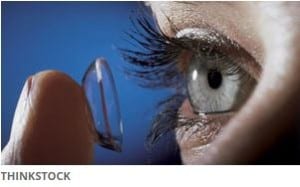Our eyes are designed to protect themselves naturally from irritation with tears and blinking. But our eyes can also be susceptible to conjunctivitis, an inflammation or infection of the thin layer of tissue that lines the inner surface of the eyelid and covers the white part of the eye. You might know conjunctivitis by a more familiar name, “pink eye.” It’s a common eye disease, especially in children. But there’s another kind of conjunctivitis, unique to people who wear contact lenses.
Giant papillary conjunctivitis
It’s a type of allergic conjunctivitis that can result from chronically having a foreign body in your eyes – your contacts, to be specific.
Signs of this painful condition

• Eye irritation such as itching, burning and redness
• The feeling of your contact moving out of place when you open and close your eyes
• Blurry vision
• Increased eye discharge
If you are experiencing any of these symptoms, you should see Dr. Croley for a diagnosis and treatment plan. Make an appointment by calling today:
(352)237-8400 or toll-free (800)521-6028.
Here’s what’s causing your symptoms
Giant papillary conjunctivitis produces large bumps under your eyelids that can even extend to your lower eyelid. The painful feeling can be similar to tiny rocks stuck under your eyelid that scratch your eye every time you blink.
Here’s some of what the doctor is likely to suggest
• Stop wearing contact lenses until all signs of irritation disappear
• Use specific eye drops to reduce itching and burning
• Follow-up with your doctor to confirm that the bumps have diminished before wearing contacts again, and limit the time you wear them
• Switch to your glasses if your eyes feel irritated
• Try a different type contact lens (made of a different material or disposable)
• Try hydrogen peroxide-based contact solution to help reduce allergen buildup
• If you continue to wear contacts, flare-ups can occur
